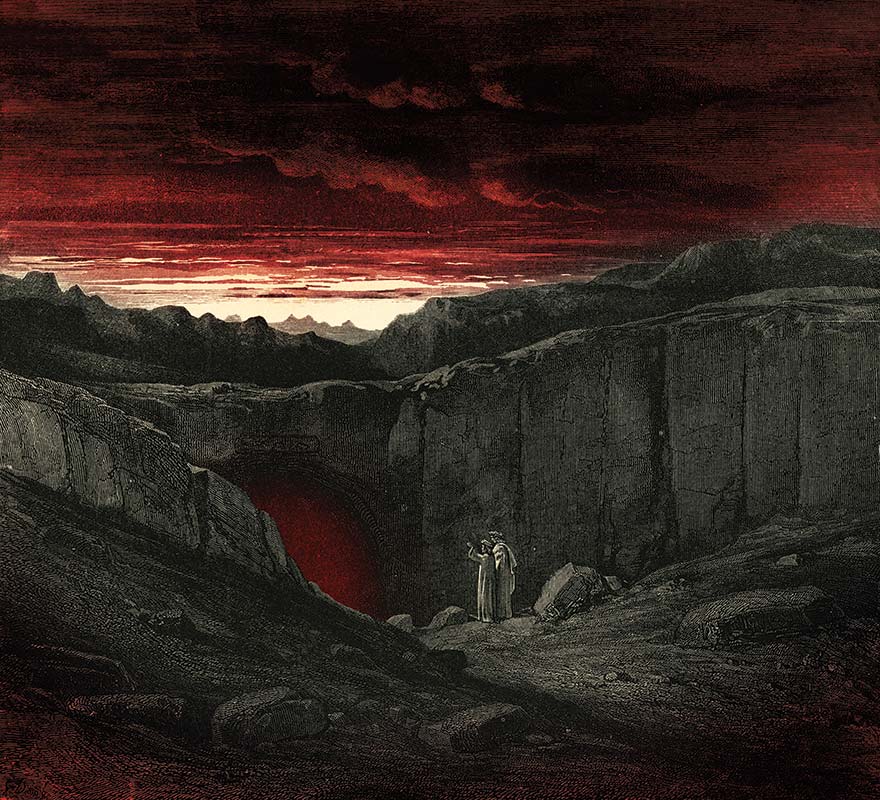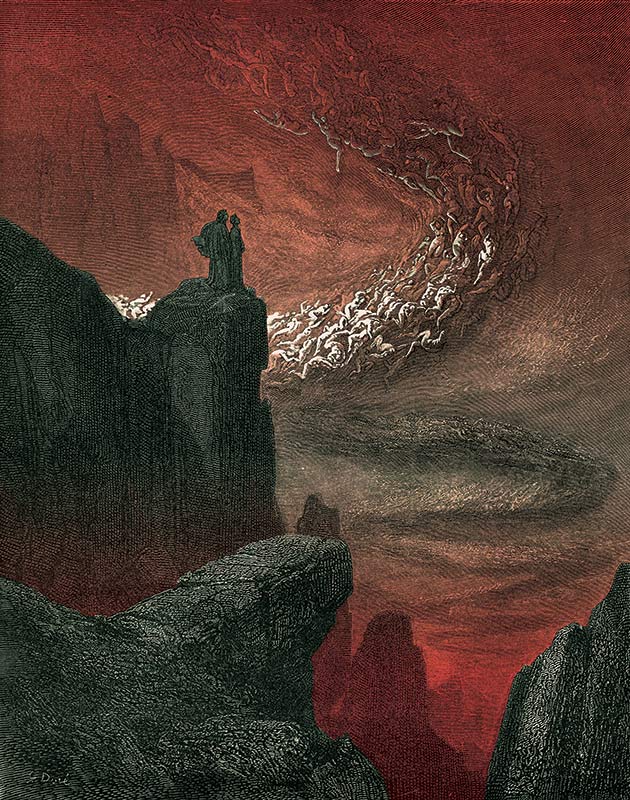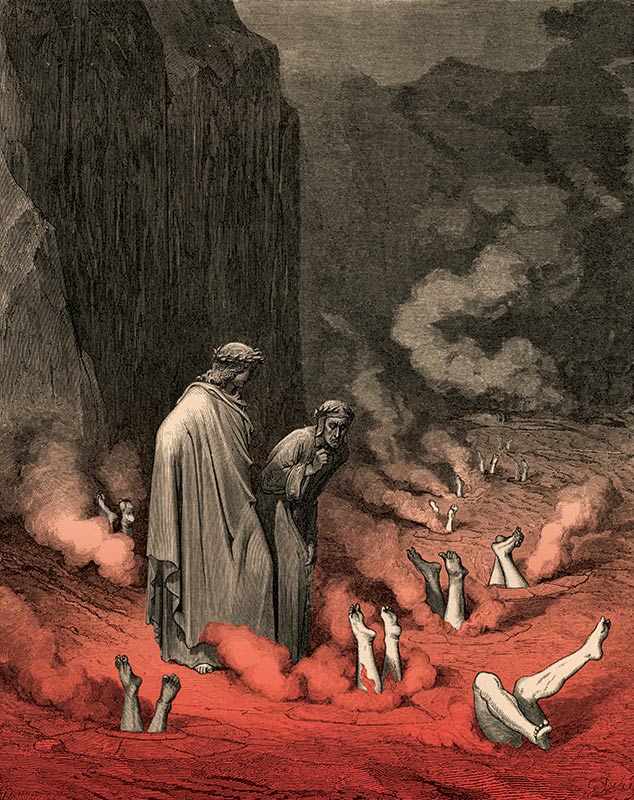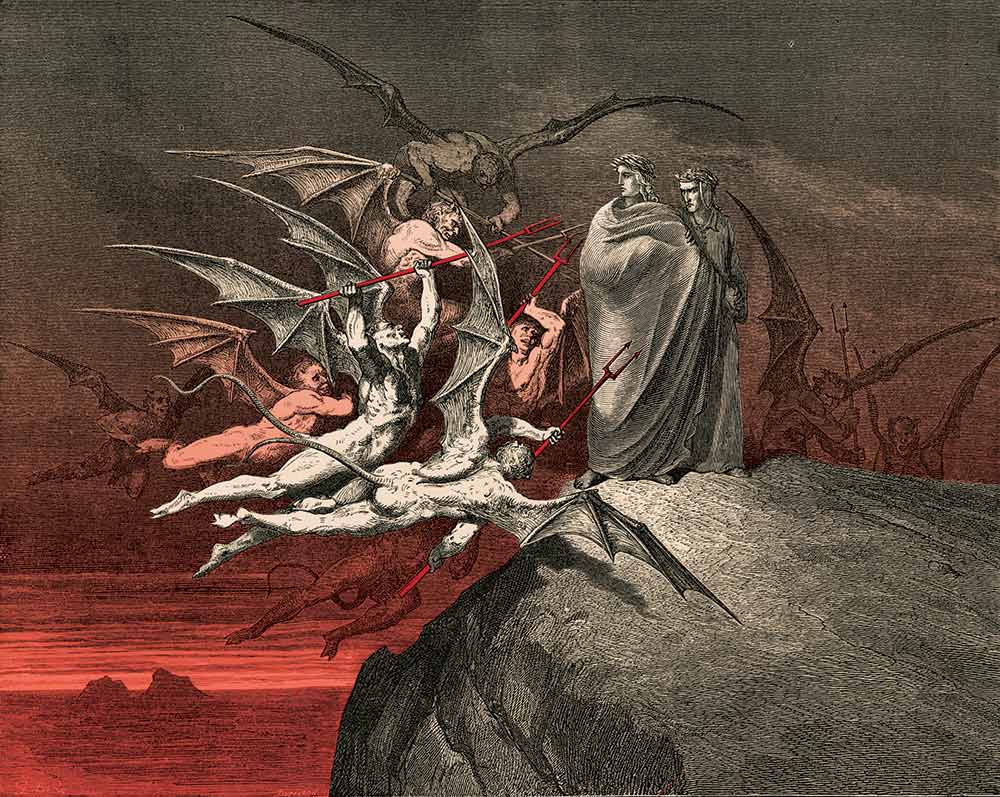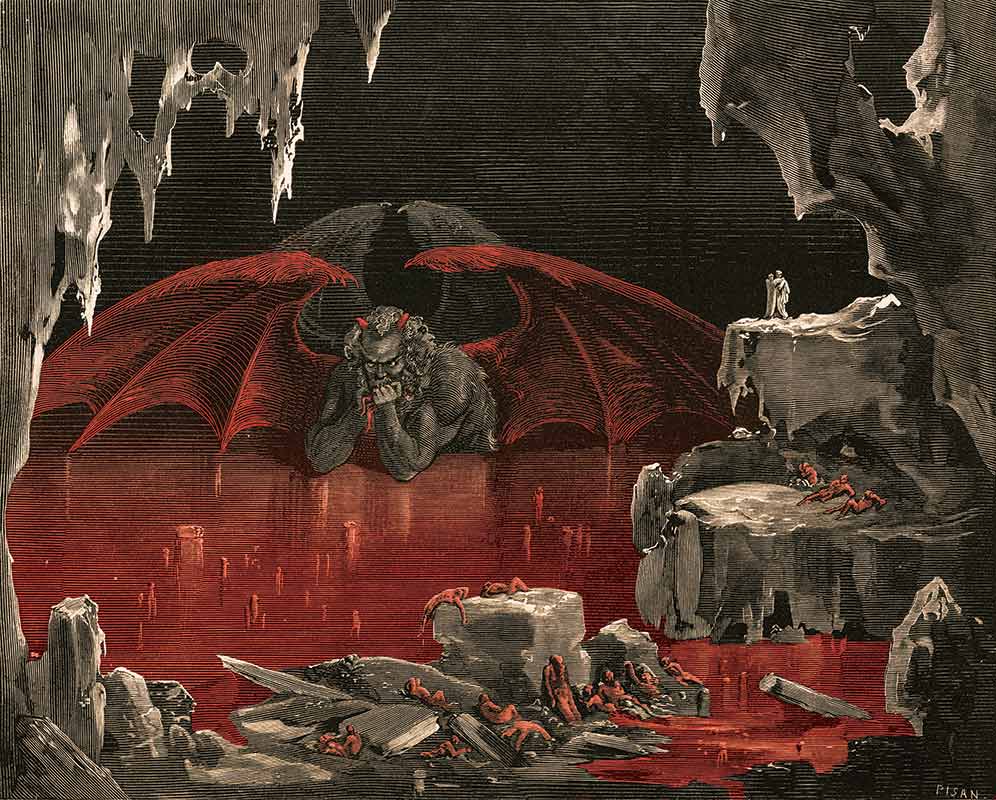The lesson from hell
Across the pop culture landscape, eternal perdition is having a moment. Broadway’s Hadestown raked in eight Tony Awards including best musical, and The Good Place is NBC’s highest-rated comedy series. Meanwhile, over on Netflix, Lucifer is solving crime while running a nightclub in Los Angeles that looks pretty spectacular, if salacious opulence is your thing. Hell is hot right now.
Honestly, it has never really cooled off. Satan, hell and the temptations that doom the damned are baked into our collective cultural consciousness through centuries of story, song and image.
Meghan Henning, an assistant professor of religious studies at the University of Dayton, sometimes asks her students for their versions of what hell might look like in today’s contemporary world.
“One of the students depicted hell as never being able to log off their phone and always seeing their friends doing things without them but never being able to message or communicate with them,” she said. “I thought it was really interesting, especially on a campus that emphasizes community and connection to one another.”
Henning teaches her students — and us — that the details of our stories about hell have changed over the centuries, reflecting evolving anxieties and fears. Our explanations for how a soul gets condemned to hell are even more important, she said. Each what-not-to-do catalog is a rhetorical mirror that reflects how we think about what it means to live a moral life and how the meaning of morality has changed through time. Hell, in other words, teaches us what it means to be good.
We tell and retell stories about hell and damnation a lot. Take, for example, how we speak to our desires with stories about the trade in souls. In a well-known 1936 Stephen Vincent Benét story, attorney Daniel Webster fights the devil in a court battle on behalf of a New Hampshire farmer who sold his soul in exchange for seven years of good crop yields. In a Benét-parodying 1993 episode of The Simpsons, Homer sues to undo a deal in which he swapped his soul for a doughnut. According to legend, Satan got Robert Johnson’s soul at a Mississippi crossroads in exchange for music talent, but the bargaining didn’t go as well when the devil went down to Georgia looking for a soul to steal, or so says the Charlie Daniels Band in its 1979 No. 1 country hit.
Satan’s offers are always alluring. He cuts a charmingly roguish figure and has for centuries. Only the best-looking actors play him and his minions. He’s by far the most interesting figure in John Milton’s epic 17th-century poem Paradise Lost, giving us delicious lines that read freshly today, like “Better to reign in Hell than serve in Heaven.” This is a guy who’s fun to hang around with.
Milton declares at the outset of Paradise Lost that he is writing about Satan and hell to “justify the ways of God to men.” This is the kind of statement of intent that deeply interests UD’s Henning, who studies what people, particularly early Christians, are trying to accomplish when they talk about hell. She loves talking about hell. She once told a podcast host that she could talk about hell all day.
Henning is the author of a study of early Christian writings about hell. When people find out what she does, the first question they usually ask her is whether she thinks hell exists.
Catholic theology is clear that it does. “The teaching of the Church affirms the existence of hell and its eternity,” reads the English version of the catechism available on the Vatican’s website. “Immediately after death, the souls of those who die in a state of mortal sin descend into hell, where they suffer the punishments of hell, ‘eternal fire.’ The chief punishment of hell is eternal separation from God.”
Recently, the Vatican’s communication’s office was forced to respond to comments attributed to Pope Francis last year by Eugenio Scalfari, the atheist founder of the Italian newspaper la Repubblica. He reported that the Pope told him that those who die in a state of mortal sin “are not punished. Those who repent obtain God’s forgiveness and take their place among the ranks of those who contemplate him, but those who do not repent and cannot be forgiven disappear.
A hell doesn’t exist; the disappearance of sinning souls exists.” The Vatican described the quote as an inaccurate transcription of the Holy Father’s comments, and Vox noted that Scalfari boasts he neither records nor takes notes during interviews, instead reconstructing conversations from memory, when it reported on the incident.
Henning, however, is a religious studies professor at a Catholic university rather than a Catholic theologian. Whether hell exists is not a question that concerns her in her academic work. To understand the questions she asks about hell, it helps to understand how she got interested in hell in the first place.
Henning grew up as part of what she calls “an active faith community” in Ohio. When she was in high school, her grandfather developed terminal lung cancer, and her grandmother did “what all Italian grandmothers would do in this situation, which is make lots of food and not sleep,” she said.
The not-sleeping caught up with her when she made a 4 a.m. grocery run, nodded off at the wheel on the way home and ran into a telephone pole. She lost a leg and was still in a coma when Henning’s grandfather died.
Friends reached out to the family, but even as a teenager, Henning sensed that words offered to comfort sometimes had the opposite effect.
“People would say to my mom things like, ‘Well, you know, when my mother was sick and in the hospital, I prayed for her and she got better, so maybe we just need to pray harder for your mom,’” she said. “These people were trying to help. They didn’t really think about the fact that they were implying to my family that what was happening to us was because we were not praying hard enough or we were not faithful enough.”
For Henning, that was the beginning of thinking about how people can read the same religious texts yet understand radically different things. The hell piece entered later, in graduate school when her mind wandered in class one day and her eyes fell on a footnote. It said, in so many words, that parts of the New Testament that dealt with hell didn’t have much to do with the testament’s overarching theological message of grace, an interpretation that struck her as a bit too modern.
“So that little daydream that I had in that seminar really got me down the path of thinking about, ‘OK, well, if I’m thinking about this from an ancient perspective, what would an ancient reader who hears this text that describes hell imagine?’”
That question led to a dissertation at Emory University that became a book, Educating Early Christians Through the Rhetoric of Hell. As the title implies, her research doesn’t contemplate hell as a place but as a tool. For her, hell is a rhetorical hammer, and she wants to know what nail it’s hitting and why. To answer those questions, she reconstructed how early Christians would have understood their own writings.
Hell is a place more like Bourbon Street in New Orleans in the dying hours of Mardi Gras.
To understand hell like an early Christian reader, you have to forget everything you know about it as a modern one. There’s never been a Dante with his nine intricately catalogued circles of hell, never been a sermon like Jonathan Edward’s “Sinners in the Hands of an Angry God” detailing the horrifying anguish that awaits unconverted souls. In the cultural landscape occupied by early Christians, hell is a place more like Bourbon Street in New Orleans in the dying hours of Mardi Gras — a menacing yet curiosity-arousing place to visit, but not anywhere you’d want to stay. The people you come across are worn-out and have nowhere else to go, and some of them are paying dearly for their earlier choices. If you can get away unscathed, you’ll have stories to tell.
Early Christians got this idea from the culture around them, which was Roman with a heavy dose of nostalgia for ancient Greece. Stories about heroes descending into Hades were as normal as will-they-or-won’t-they plotlines in today’s romantic comedies. The ancient archetype we know today occurs in Homer’s The Odyssey, the Bronze Age epic that tells the story of Odysseus’ 10-year struggle to get home after the Trojan War.
The Hades that Homer describes would have been more recognizable to early Christians than many of our modern conceptions of hell. When Odysseus gets to the land of the dead, he sees all kinds of people, including many well-known ones. There’s his mother, Anticleia, and an unburied former crew member named Elpenorn. The blind prophet Tiresias drops by to give advice. Warriors’ wives and daughters stop to chat, as do Achilles, Agamemnon and the mother of Oedipus, Epicaste. Odysseus also spots Tantalus being tortured by thirst as he stands in a pool of unreachable water, Sisyphus heedlessly pushing his rock uphill, and others enduring eternal torment for various offenses against the gods.
The elements of Homer’s telling — the descent, the encounters with well-known characters, the suffering — were familiar structures for early Christians, according to Henning.
 “The myth of the descent into Hades was popular and widely referenced,” she said. “When an ancient person would hear someone say, ‘You know, I went on this journey to the underworld,’ or ‘I went on a trip to Hades,’ the idea of such a thing would be familiar enough that, instead of asking ‘Really? Is that a real place?’ or ‘What was there?’ the person would ask instead, ‘Well, who did you see?’”
“The myth of the descent into Hades was popular and widely referenced,” she said. “When an ancient person would hear someone say, ‘You know, I went on this journey to the underworld,’ or ‘I went on a trip to Hades,’ the idea of such a thing would be familiar enough that, instead of asking ‘Really? Is that a real place?’ or ‘What was there?’ the person would ask instead, ‘Well, who did you see?’”
One reason for the saturation of these stories in the culture of antiquity is that they were widely used to help teach morality. What one saw and who one met in an underworld had “an ethical orientation, aimed at providing instructions for how people ought to conduct themselves in their mortal lives,” Henning writes in her book.
Afterlife stories about punishment, in particular, were commonly used to teach students about the rhetorical concept of ekphrasis, or the use of visual imagery conveyed with words to move an audience, so students throughout antiquity were familiar with the form. In Plato’s Republic, the visual descriptions of suffering underscore the importance of living a life of moderation. Roman satirist Lucian flips social hierarchy in his underworld, with kings and governors “either selling salt fish on account of their neediness or teaching the alphabet, and getting abused and hit over the head by all comers,” Henning notes in a footnote.
That highly visual language — “selling salt fish,” “getting abused and hit over the head” — creates vivid descriptions with a moral purpose: to warn to the rich and powerful about how they ought to be living their lives. Plutarch, in another of Henning’s examples, details the colors of the wounds of those suffering in the afterlife and attributes them to particular sins. “Drab brown … comes of meanness and greed,” for example, “while if spite and envy are present, they give out this livid green.”
When the early Christians write about hell, they’re riffing on something already out there, not coming up with a new tune.
Homer. Plato. Lucian. Plutarch. These storytellers have a sort of “All Along the Watchtower” effect going on. The original version of the song comes from Bob Dylan, but then Jimi Hendrix took it and made it his own. Decades later, U2 gave it a shot on their album Rattle and Hum, and plenty more have continued reworking it. Likewise, when the early Christians write about hell, they’re riffing on something already out there, not coming up with something completely new.
These examples from Homer and the rest offer a sense of the rhetorical practices in which early Christians are participating when they write their gospels, epistles and other texts. Homer is Dylan, Plato is Hendrix and, as the New Testament writers dip their reeds in ink, they are U2’s lead singer Bono clearing his throat. They’ve got a structure for how to think about the afterlife and what awaits the damned. Now’s their turn to rock the hell story in a way that explains how they believe Jesus has called them to live.
Though Henning offers examples from throughout the New Testament of how they do this, she devotes an entire chapter of her book to Matthew’s Gospel. It is rife with imagery of punishments — eternal fire, weeping and gnashing of teeth, outer darkness and more — that illustrate what awaits those who do not follow the path to righteousness laid out by Jesus.
“In Matthew, the vivid depictions of ‘hell’ functioned in much the same way that it did for the Greek readers of The Odyssey, as a tool for broad ethical and cultural education,” Henning writes.
Early Christians created vivid hells in service of a broader message of concern with the marginalized in our world.
On the flip side, the virtues on which Matthew focuses prove to be exceptionally influential on early Christians, particularly his account of Christ’s Sermon on the Mount, which begins “Blessed are the poor in spirit,” commands love of one’s enemy, warns against piety and wealth-seeking, and gives us the “Do unto others” golden rule.
As more early Christians wrote new texts, including the epistles of the New Testament and works such as the Apocalypse of Peter and the Latin Vision of Ezra, they picked up on and elaborated Matthew’s themes. They used the “tried and true [hell] rhetoric of empire” to present “their own distinctive values,” Henning writes, often describing “the punishment of those who do not care for ‘the other’” and using new hell stories to “[draw] upon the Sermon of the Mount as an ethical core that could bring cohesion to early Christian communities.” This theme emerged at a critical time for early Christians, when they were still in the early stages of identity formation and deciding which texts and messages would be their exemplars.
Two thousand or so years later, we’re still talking about hell. But Henning will tell you we’re creating hell stories not only in different ways today, but for different reasons.
“Unfortunately, what I think has happened is that we’ve picked up on the rhetoric — which is really kind of a trick from the Greco-Roman world — and we have not brought with it any of the ethical content,” she said. “The real focus of hell in the New Testament and early Christian texts is really on care for the other and love of the neighbor. But when we depict hell in modern media, we’ve actually pivoted away from that and have focused more on the rhetoric itself and the violent imagery.”
This turn away from using hell depictions to focus an audience on virtues is not just secular. Henning cites the example of so-called “hell houses,” a phenomenon of evangelical Christianity in America whose purpose is straight out of Jonathan Edward’s 1741 sermon to encourage religious conversion. These houses feature depictions of gruesome punishments linked to sins that “usually include abortion, homosexuality, consumption of alcohol and recreational drugs, suicide, pre-marital sex, and other sins that are of primary concern to evangelical Christians.” In this catalog of transgressions, “the early Christian emphasis on the virtues presented in the Sermon on the Mount is all but lost.”
Although Henning’s study of hell is driven by academic curiosity rather than the religious concerns of a theologian, she laments the loss of what she calls the “pedagogical savvy” of the early Christians as they created vivid hells in service of a broader message of concern with the marginalized in our world.
Henning works to reclaim their teachings in The Road to Hell, a course she and communication professor Joseph Valenzano III designed and teach together.
Henning said that when they start teaching hell, their students “want to quickly go to the entertainment value,” she said. This impulse reflects their experience with depictions of hell in popular culture, including ultra-violent ones such as the Saw horror movie franchise, which, she said, “uses the same kind of measure-for-measure punishment stuff that early Christian depictions of hell do, but intensifies it. … It’s even grosser than you could imagine.”
When Henning assigns her students to analyze modern depictions of hell, they typically will train their critical lenses on comparatively less disturbing depictions of the afterlife, such as in Stranger Things or American Horror Story — even Harry Potter.
“The image when Harry dies for a short period of time and he’s in this void — students actually compare that to different ancient depictions of a kind of neutral afterlife, like Greek and Roman depictions of Hades that don’t have punishment or Hebrew Bible notions of Sheol,” she said.
Henning really likes NBC’s The Good Place, which she describes as an especially nuanced exception to the violence that pervades contemporary hell depictions. In it, Eleanor Shellstrop (played by Kristen Bell) believes she is in heaven by mistake. But — spoiler alert — her crippling doubts are a form of psychological torture being inflicted on her in a version of hell constructed by a demon architect (played by Ted Danson) who is trying to freshen up the whole agony paradigm. The show creates a world in which these and other characters are forced to reflect on what is just, what is unjust and how justice should be restored. Somewhere, sometime soon, if it isn’t already happening, a graduate student ought to be typing up a dissertation on The Good Place as an embodiment of 21st-century American anxiety about unearned privilege.
We don’t need to rely on hell stories for communicating about what it means to live virtuously, Henning points out.
“I think that we have a lot more rhetorical tools at our disposal than ancient Christians did,” she said. “I think the question is, ‘What are the best rhetorical tools in our world, and how can we maximally use them to do that good work in the world?’”
Social media, for all its faults, offers a good example. Henning — who also has a strong interest in disability studies, which she attributes to seeing her grandmother cope with the loss of her leg after her car accident — has watched as disability activists use social media campaigns to create new ethical boundaries for how media companies serve customers who need, for example, closed captioning services. Activists no longer require hell-inspired storytelling to get the public to pay attention or change its ways.
Early Christians might easily recognize the rhetorical point we’re making in one specific way we talk about hell today. Type a Google search for recent news that includes the word “hell,” and you’ll turn up the usual stories about airline “travel hell” or “the neighbor from hell.” But sprinkled among the usual suspects will be stories that describe one circumstance or another as “hell on Earth.” It might be the fate of a community victimized by war, the last days of an abused child, a pocket of indescribably deep poverty in a distant country or nearby place, or some other dire, desperate situation.
These are hells that confront us with the moral urgency of caring for the most marginalized and vulnerable who suffer among us today.
No matter the lamentable particulars, one shared element defines these stories as hellscapes: the undeserved torment of blameless innocents. Here, the usual hell story is turned inside-out. These are not hells where the wicked are being punished. These are hells that confront us with the moral urgency of caring for the most marginalized and vulnerable who suffer among us today. In these stories at least, hell still calls us to follow the early Christians’ message about how we ought to live.
Matthew Dewald is a writer in Richmond, Virginia, and a former University of Dayton staff member. His most recent stories for this magazine examined courtesy and miracles.
The etchings of hell in this feature are by Gustave Doré, a 19th century French artist. (Colorization added.) He created the black-and-white images of the travels of Dante and Virgil for the 1866 edition of The Vision of Hell, an English translation by Henry Francis Clay of “Inferno” in the Divine Comedy by Dante Alighieri. The edition is part of the rare books collection of UD’s archives. Also included in the collection is a 1963 edition of the Divine Comedy illustrated by Salvador Dali and used by students in the Road to Hell class. Special thanks to University Libraries.
